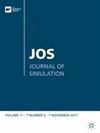Decoupling visualisation for better DEVS-based simulation applications
IF 1.7
4区 工程技术
Q4 COMPUTER SCIENCE, INTERDISCIPLINARY APPLICATIONS
引用次数: 0
Abstract
ABSTRACTSimulation visualisation is an effective way of understanding and communicating complex systems and processes. Among other advantages, it increases model transparency and intelligibility for all categories of users including non-experts, and it can be used by modellers as a tool to debug models in development. However, simulation visualisation is often tightly coupled to specific simulators, and, therefore, there is no way to reuse visualisation tools efficiently. Here, we present a specification that can be used to decouple visualisation engines from simulators. The specification also considers storage optimisation to support web-based simulation applications. We also present an implementation that supports the web-based representation and animation of outputs issued from simulators based on the discrete event system specification (DEVS) and Petri Nets.KEYWORDS: Decoupled visualisationvisualisation interoperabilitysimulation environment AcknowledgmentsThe authors would like to acknowledge Compute Canada for providing access to their Arbutus cloud-based infrastructure that allowed us to develop and test an implementation of the work we presented. The research was partially funded by NSERC.Disclosure statementNo potential conflict of interest was reported by the author(s).Additional informationFundingThis work was supported by the NSERC - Canada.为更好的基于devs的仿真应用提供解耦可视化
摘要仿真可视化是理解和交流复杂系统和过程的有效途径。在其他优点中,它为包括非专家在内的所有类别的用户增加了模型的透明度和可理解性,并且它可以被建模者用作开发中调试模型的工具。然而,仿真可视化通常与特定的模拟器紧密耦合,因此,没有办法有效地重用可视化工具。在这里,我们提出了一个规范,可用于将可视化引擎与模拟器解耦。该规范还考虑了存储优化,以支持基于web的仿真应用程序。我们还提出了一个基于离散事件系统规范(DEVS)和Petri网的实现,该实现支持基于web的表示和仿真器发出的输出动画。致谢致谢致谢致谢致谢致谢致谢致谢致谢致谢致谢致谢致谢致谢致谢致谢致谢致谢致谢致谢致谢致谢致谢致谢致谢致谢致谢致谢致谢致谢致谢致谢致谢致谢致谢致谢致谢致谢致谢致谢致谢该研究部分由NSERC资助。披露声明作者未报告潜在的利益冲突。本研究得到了加拿大国家科学研究委员会的支持。
本文章由计算机程序翻译,如有差异,请以英文原文为准。
求助全文
约1分钟内获得全文
求助全文
来源期刊

Journal of Simulation
COMPUTER SCIENCE, INTERDISCIPLINARY APPLICATIONS-OPERATIONS RESEARCH & MANAGEMENT SCIENCE
CiteScore
5.70
自引率
16.00%
发文量
42
期刊介绍:
Journal of Simulation (JOS) aims to publish both articles and technical notes from researchers and practitioners active in the field of simulation. In JOS, the field of simulation includes the techniques, tools, methods and technologies of the application and the use of discrete-event simulation, agent-based modelling and system dynamics.
 求助内容:
求助内容: 应助结果提醒方式:
应助结果提醒方式:


